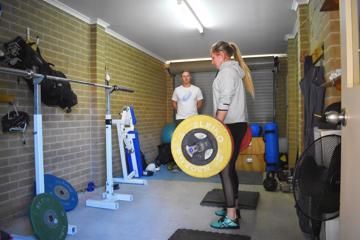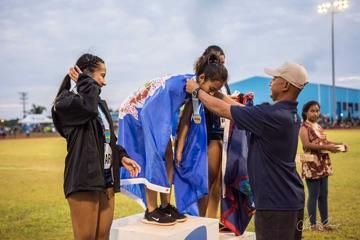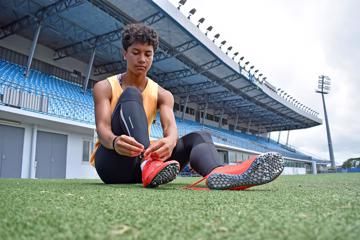Brandon Starc in training (© Getty Images)
Apart from international travel restrictions, it as business as usual for the sport of athletics in New Zealand.
The country is feeling the benefit of an early and decisive lockdown which has limited the health implications of the Covid-19 pandemic and the country has relatively quickly returned to normality with no need for social distancing.
“We are delighted to be back in a position where once again normal competition can occur,” explains Athletics New Zealand CEO Pete Pfitzinger. “We have had to shift our winter season of cross country and road running back by about five weeks only and very few events have been cancelled.”
New Zealand is one of the very few countries in the world in 2020 to so far host a national track and field championships – completed in Christchurch just a couple of weeks before lockdown restrictions were put in place.
As an organisation it reacted quickly to the vastly different circumstances under a full lockdown, communicating regularly via Zoom to its 11 regional bodies and setting up a successful virtual series of races, which attracted more than 1500 participants.
“It was important to get the series going,” explains Pfitzinger, who competed in the marathon for the USA at the 1984 Los Angeles and 1988 Seoul Olympics. “There was a lot of doom and gloom at the time about people only being able to go out to the supermarket, and even when going for a walk or run you were not allowed to stray too far from home. Of course, we were very sensitive in our wording about where people were allowed to run as part of the series. But it was a success and generated a lot of buzz and engagement. It was important for people, psychologically, to compete again. There was a great deal of enthusiasm for the concept.”
Talks are also currently ongoing with Australia – should travel be opened up in the region – for more meets later this year.
“All our athletes are back in full training and that is definitely an advantage,” explains Pfitzinger. “Life for us is back to normal.”
Christian Malcolm, Athletics Australia’s head of high performance and coaching, says the lockdown has given them an opportunity to look at the calendar and work out how they can adapt competitions.
“One unknown is that we don’t know whether there is going to be international competition and when it will be able to commence,” he says. “If it is on, can our athletes get there? In either case, Australia and New Zealand can work together so we need to bring New Zealand into our calendar.
“In relation to the calendar, the timing is also important. Do you lengthen the (southern hemisphere) season so that it runs into the Oceania Championships in May? We need to schedule training camps and holding camps if we can go to the Olympic Games, but not if we cannot. And the financial implications – can we resource these programmes?
“There are great learnings in it for us all,” he added. “It won’t get any more challenging than this current period.”
McCartney, Marschall and Stevens: injured in 2019, excited by 2021
Back in full training, Olympic pole vault bronze medallist Eliza McCartney is currently attending a training base in Hawke’s Bay for New Zealand’s leading field event athletes.
The 23-year-old has endured injury struggles in recent seasons but is now fully fit and refreshed and believes the past few months have set up nicely her for a strong 2021 campaign.
When the country went into lockdown in late-March, McCartney, who last competed at the 2019 Zurich Diamond League last August, used the period to build up her base fitness.
“It was good for me because for the first time in a long time because I was injury-free, I could go for a 20-minute run and not feel pain,” she explains. “Just before lockdown, I managed to source some gym equipment from High Performance Sport NZ. I did some cross-training activities, circuits and weights and yoga at home. I put in a really good base training block.”
McCartney was also forced to improvise during lockdown using her boyfriend’s kitesurfing bar, attached by rope to a tree, for chin ups and using full white wine bottles as substitute weights because the 4.94m vaulter was lacking small dumbbells.
Since the country has gone down alert levels, she has returned to her regular training facility in Auckland as is back vaulting again injury-free.
With so few Covid-19 cases in New Zealand, McCartney fully acknowledges how fortunate the country is currently positioned in its fight against the pandemic.
She praises the outstanding leadership shown by Prime Minister Jacinda Ardern through the pandemic while the decision to postpone the Tokyo Olympics until 2021 could works in her favour.
“To have that extra year to prepare for the Olympics is a real bonus,” she says. “I haven’t had a winter training in New Zealand in many years because I’ve been in Europe competing. To have enjoyed that period of base training has allowed me to work on my strength and the potential gains are really exciting.”
For Australian pole vaulter Kurtis Marschall, the past 18 months or so could best be described as a “rollercoaster” of a journey.
Flashes of outstanding form have all too often been stalled by injury setbacks, but following a 10-week period in lockdown, the Commonwealth champion hopes to make a welcome return to the pole vault runway next week after he recently returned to his regular training base in Perth.
Marschall had begun 2019 with a bang, clearing an absolute lifetime best of 5.87m at an indoor meet in Clermont-Ferrand, France, only to return home to Australia with a niggly shoulder injury.
Struggling with the injury, he finished down in sixth at the Australian Championships. With the damaged shoulder exerting extra pressure on other parts of the body, this led to a stress fracture of the lower back, which caused him to abandon plans to compete on the European circuit and at the season-ending World Athletics Championships in Doha.
On top of the injury, Marschall also underwent a coaching change in the middle of 2019, switching from Alex Parnov, who opted to retire from the sport, to be guided by three-time Olympian and 6.00m vaulter Paul Burgess.
“Back in the day Alex used to coach Paul, so the pair share the same technical model and eye for the vault,” he explains. “Although I think Paul’s programming and understanding of periodisation is a little bit more modern than Alex because he is the younger guy.”
Returning to full training in September, Marschall made a successful season debut, clearing an Olympic qualification standard of 5.80m at the Perth Track Classic – just one centimetre shy of his outdoor PB.
View this post on InstagramLittle snippet of quarantine training, after returning to Perth 1 week ago 🏋🏽♂️ /// *1 week to go 😴
Once lockdown started in Australia, he moved to the Western Coast to spend time with his girlfriend Olivia Eaton (a sprinter from New Zealand). Sourcing training equipment from a nearby gym and running in a local park, he opted to not even attempt to vault during this period and focused instead on other areas of his training.
“My fitness and strength and conditioning have come a long way during this time,” he explains. “And not doing any vaulting has probably been good for my back. I’ve made some gains in thoracic range and pelvis strength, which will put me in a good position when I return to vaulting.”
His return to action looks set to happen in 2021.
“To be able to perform competition after competition next year, I need to get a solid base under my belt,” he explains. “I’m definitely working towards next season and competing at World Indoors, on the European circuit and at the Olympics. But I definitely need the rest of this year to be in the right spot to come out hard next year.”
For 2009 world discus champion Dani Stevens the past couple of years have certainly not gone according to the script.
A back injury ruled the Australian out of the 2019 World Athletics Championships in Doha, and earlier this year she underwent surgery to fix an acute bulging disc in her neck. With the training disruptions generated by the Covid-19 pandemic, the challenges have come thick and fast.
But Stevens believes the decision to re-schedule the 2020 Olympics to next year could work in her favour.
“After undergoing surgery in February and then rehabbing, to hear that the Olympics had been postponed was a bit of a relief for me,” explains Stevens. “I had a fairly serious injury, which needed some time to heal. I was grateful for the extra time as I now have an extra 12 months to prepare for the Olympics.”
Stevens unleashed the greatest throw of her career so far when setting an Oceania record of 69.64m to earn silver at the 2017 World Athletics Championships. She then went on to enjoy more success the following year, retaining her Commonwealth title in front of her home fans at the Gold Coast Games.
She made a brief return to action in November 2019, throwing an Olympic qualifying mark of 65.93m in Sydney, but injury then intervened once again.
“I got an acute bulging disc in my neck that popped out and pushed on to a nerve root, which meant I couldn’t move my right arm,” she adds. “The surgery was urgent and needed to be done quickly.”
Just as her arm started to improve, Covid-19 made its unwelcome introduction and Australia started to go into lockdown in late-March.
“For me, training in the garage at home and undergoing heavy rehab was not in too bad a situation,” she says.
With the neck no longer an issue and the right arm rapidly improving, Stevens is back throwing again. But while gyms have now reopened in Queensland, competition could still be some time away.
“Because of the fact I’m still some way short of throwing at 100% intensity, I have no plans to compete in overseas competition from August through to October,” she says. “I just have to be patient and know I have an extra 12 months to prepare for the Olympics, which is quite fortunate.”
Champion athletes Barber and Starc ready to return – if situation allows
World javelin champion Kelsey-Lee Barber hasn’t had to make too many changes to her training in recent months.
“I’ve been able to keep the continuity in my training and work towards my goals for next year,” says Barber, who set up a home gym in her garage. “We took some time to accept there were changes happening, so we sat down and tried to put together a constructive manner in which we can use this time. What we’re working towards is pushing my growth further. I want to go into next year at the top of my game and walk into the Olympics as one of the favourites to win a gold medal.
“We’re trying to take the time and the opportunity this gives to build my strength and capacities to make me a 70-metre thrower.
“I’d love to get to the Diamond League meetings, but we’re realistic about the ability to travel and the advice now remains ‘don’t go’. There should be local competition starting up at the end of this year and we’ll pick two or three competitions in Canberra and maybe Brisbane. All being well, we’ll approach 2021 pretty much exactly as if it would have been this year.”

Brandon Starc, the 2018 Diamond League high jump champion and Commonwealth gold medallist, has been trying to replicate competition scenarios in training, using it to measure his form.
“We tried to stick as close as possible to our competition plan, doing mock comps in training,” said Starc’s coach, Alex Stewart. “He cleared 2.31m in one of those, which is the highest he’s ever jumped at that time of year.”
And while Starc, like Barber, would love to make some Diamond League appearances this year, he is happy to wait until 2021.
“The international scene is huge for us,” he said. “The postponement (of the Olympics) is actually a bummer. I was training super well, doing training PBs these past couple of weeks. I was ready for this year. I’m in great shape right now.
“But rather than dwell on the negatives, I’m looking at the positives. Maybe I can jump even higher, and maybe I’ll be much stronger and faster when Tokyo comes around.”
Steve Landells and Len Johnson for World Athletics








